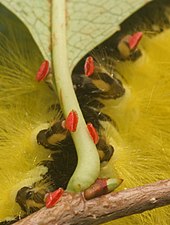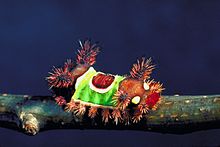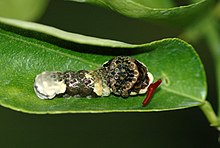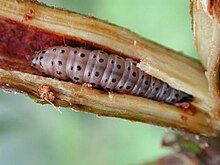Caterpillar.
From Wikipedia, the free encyclopedia
Caterpillar /ˈkætərˌpɪlər/ is the common name for the larvae of members of the order Lepidoptera (the insect order comprising butterfliesand moths).
As with most common names, the application of the word is arbitrary and the larvae of sawflies commonly are called caterpillars as well.[1][2]
Caterpillars of most species are herbivorous, but not all; some are insectivorous, even cannibalistic. Some feed on other animal products; for example clothes moths feed on wool, and horn moths feed on the hooves and horns of dead ungulates.
Caterpillars as a rule are voracious feeders and many of them are among the most serious of agricultural pests. In fact many moth speciesare best known in their caterpillar stages because of the damage they cause to fruits and other agricultural produce, whereas the moths are obscure and do no direct harm. Conversely, various species of caterpillar are valued as sources of silk, as human or animal food, or for biological control of pest plants.
Contents
[hide]Etymology[edit]
The origins of the word "caterpillar" date from the early 16th century. They derive from Middle English catirpel, catirpeller, probably an alteration of Old North French catepelose:cate, cat (from Latin cattus) + pelose, hairy (from Latin pilōsus).[3]
Classification[edit]
The geometrids, also known as inchworms or loopers, are so named because of the way they move, appearing to measure the earth (the word geometrid means earth-measurer in Greek); the primary reason for this unusual locomotion is the elimination of nearly all the prolegs except the clasper on the terminal segment.
Caterpillars have soft bodies that can grow rapidly between moults. Only the head capsule is hardened. The mandibles are tough and sharp for chewing leaves (this contrasts with most adult Lepidoptera, which have highly reduced or soft mandibles). Behind the mandibles of the caterpillar are the spinnerets, for manipulating silk. Antennae are present on either side of the labrum, but small and relatively inconspicuous.[4]
Some larvae of the Hymenoptera order (ants, bees and wasps) can appear like the caterpillars of the Lepidoptera. Such larvae are mainly seen in the sawfly family. However while these larvae superficially resemble caterpillars, they can be distinguished by the presence of prolegs on every abdominal segment, an absence of crochets or hooks on the prolegs (these are present on lepidopteran caterpillars), prominent ocelli on the head capsule, and an absence of the upside-down Y-shaped suture on the front of the head.[5]
Caterpillars can be confused with the larvae of sawflies (see image on right). Lepidopteran larvae can be differentiated by:
- the numbers of pairs of pro-legs; sawfly larvae have 6 while caterpillars have up to 5 pairs.
- the number of stemmata (simple eyes); the sawfly larvae have only two, while a caterpillar has six.
- the presence of crochets on the prolegs; these are absent in the Symphyta (sawflies).
- sawfly larvae have an invariably smooth head capsule with no cleavage lines, while lepidopterous caterpillars bear an inverted "Y" or "V" (adfrontal suture).
Defenses[edit]
Many animals feed on caterpillars as they are rich in protein. As a result, caterpillars have evolved various means of defense. The appearance of a caterpillar can often repel a predator: its markings and certain body parts can make it seem poisonous, or bigger in size and thus threatening, or non-edible. Some types of caterpillars are indeed poisonous.
Caterpillars have evolved defenses against physical conditions such as cold, hot or dry environmental conditions. Some Arctic species likeGynaephora groenlandica have special basking and aggregation behaviours[6] apart from physiological adaptations to remain in a dormant state.[7]
Appearance[edit]
Many caterpillars are cryptically colored and resemble the plants on which they feed. They may even have parts that mimic plant parts such as thorns. Their size varies from as little as 1 mm to about 75 millimetres (3.0 in). Some look like objects in the environment such as bird droppings. Many feed enclosed inside silk galleries, rolled leaves or by mining between the leaf surfaces. Caterpillars of Nemoria arizonaria that grow in spring feed on oak catkins and appear green. The summer brood appear like oak twigs. The differential development is linked to the tannin content in the diet.[8]
Chemical defenses[edit]
More aggressive self-defense measures are taken by some caterpillars. These measures include having spiny bristles or long fine hair-likesetae with detachable tips that will irritate by lodging in the skin or mucous membranes.[5] However some birds (such as cuckoos) will swallow even the hairiest of caterpillars. Other caterpillars acquire toxins from their host plants that render them unpalatable to most of their predators. For instance, ornate moth caterpillars utilize pyrrolizidine alkaloids that they obtain from their food plants to deter predators.[9] The most aggressive caterpillar defenses are bristles associated with venom glands. These bristles are called urticating hairs. A venom which is among the most potent defensive chemicals in any animal is produced by the South American silk moth genus Lonomia. Its venom is an anticoagulant powerful enough to cause a human to hemorrhage to death (See Lonomiasis).[10] This chemical is being investigated for potential medical applications. Most urticating hairs range in effect from mild irritation to dermatitis.
Plants contain toxins which protect them from herbivores, but some caterpillars have evolved countermeasures which enable them to eat the leaves of such toxic plants. In addition to being unaffected by the poison, the caterpillars sequester it in their body, making them highly toxic to predators. The chemicals are also carried on into the adult stages. These toxic species, such as the cinnabar moth (Tyria jacobaeae) and monarch (Danaus plexippus) caterpillars, usually advertise themselves with the danger colors of red, yellow and black, often in bright stripes (see aposematism). Any predator that attempts to eat a caterpillar with an aggressive defense mechanism will learn and avoid future attempts.
Some caterpillars regurgitate acidic digestive juices at attacking enemies. Many papilionid larvae produce bad smells from extrudable glands called osmeteria.
Defensive behaviors[edit]
Some caterpillars, like the tomato hornworm and tobacco hornworm, have long "whip-like" organs attached to the ends of their body. The caterpillar wiggles these organs to frighten away flies and predatory wasps.[11] Some caterpillars can evade predators by using a silk line and dropping off from branches when disturbed. Many species thrash about violently when disturbed to scare away potential predators. One species (Amorpha juglandis) even makes high pitched whistles that can scare away birds.[12] Pine processionary(Thaumetopoea pityocampa) caterpillars often link into a long train, moving through trees or over the ground like a snake.[citation needed] The head of the lead caterpillar is visible, but all other heads are hidden.
Use of other insects[edit]
Some caterpillars obtain protection by associating themselves with ants. The Lycaenid butterflies are particularly well known for this. They communicate with their ant protectors by vibrations as well as chemical means and typically provide food rewards.[13]
Some caterpillars are gregarious; large aggregations are believed to help in reducing the levels of parasitization and predation.[14] Clusters amplify the signal of aposematic coloration, and individuals may participate in group regurgitation or displays.
Predators[edit]
The caterpillar suffers predation from a number of species. The European pied flycatcher is one species that preys upon caterpillars. The flycatcher typically finds caterpillars amongst oak foliage. Paper wasps, like Polistes metrics, Polistes apachus, and Polistes instabilis', also catch caterpillars to feed their young and themselves. Green and brown caterpillars are the most common prey for Polybia sericea.
Behavior[edit]
Caterpillars have been called "eating machines", and eat leaves voraciously. Most species shed their skin four or five times as their bodies grow, and they eventually pupate into an adult form.[15] Caterpillars grow very quickly; for instance, a tobacco hornworm will increase its weight ten-thousandfold in less than twenty days. An adaptation that enables them to eat so much is a mechanism in a specialized midgut that quickly transports ions to the lumen (midgut cavity), to keep the potassium level higher in the midgut cavity than in the blood.[16]
Most caterpillars are solely herbivorous. Many are restricted to one species of plant, while others are polyphagous. A few, including the clothes moth, feed on detritus. Most predatory caterpillars feed on eggs of other insects, aphids, scale insects, or ant larvae. Some are predatory, and others prey on caterpillars of other species (e.g. Hawaiian Eupithecia). A few are parasitic on cicadas or leaf hoppers.[17] Some Hawaiian caterpillars (Hyposmocoma molluscivora) use silk traps to capture snails.[18]
Many caterpillars are nocturnal. For example, the "cutworms" (of the Noctuidae family) hide at the base of plants during the day and only feed at night.[19] Others, such as gypsy moth (Lymantria dispar) larvae, change their activity patterns depending on density and larval stage, with more diurnal feeding in early instars and high densities.[20]
Economic effects[edit]
Caterpillars cause much damage, mainly by eating leaves. The propensity for damage is enhanced by monocultural farming practices, especially where the caterpillar is specifically adapted to the host plant under cultivation. The cotton bollworm causes enormous losses. Other species eat food crops. Caterpillars have been the target of pest control through the use of pesticides, biological control andagronomic practices. Many species have become resistant to pesticides. Bacterial toxins such as those from Bacillus thuringiensis which are evolved to affect the gut of Lepidoptera have been used in sprays of bacterial spores, toxin extracts and also by incorporating genes to produce them within the host plants. These approaches are defeated over time by the evolution of resistance mechanisms in the insects.[21]
Plants evolve mechanisms of resistance to being eaten by caterpillars, including the evolution of chemical toxins and physical barriers such as hairs. Incorporating host plant resistance (HPR) through plant breeding is another approach used in reducing the impact of caterpillars on crop plants.[22]
Human health[edit]
Caterpillar hair can be a cause of human health problems. Caterpillar hairs sometimes have venoms in them and species from approximately 12 families of moths or butterflies worldwide can inflict serious human injuries ranging from urticarial dermatitis and atopic asthma to osteochondritis, consumption coagulopathy, renal failure, and intracerebral hemorrhage.[23] Skin rashes are the most common, but there have been fatalities.[24]Lonomia is a frequent cause of envenomation in Brazil, with 354 cases reported between 1989 and 2005. Lethality ranging up to 20% with death caused most often by intracranial hemorrhage.[25]
Caterpillar hair have also been known to cause kerato-conjunctivitis. The sharp barbs on the end of caterpillar hairs can get lodged in soft tissues and mucous membranes such as the eyes. Once they enter such tissues, they can be difficult to extract, often exacerbating the problem as they migrate across the membrane.[26]
This becomes a particular problem in an indoor setting. The hair easily enter buildings through ventilation systems and accumulate in indoor environments because of their small size, which makes it difficult for them to be vented out. This accumulation increases the risk of human contact in indoor environments.[27]
Caterpillars are a food source in some cultures. For example, in South Africa mopane worms are eaten by the bushmen, and in China silkwormsare considered a delicacy.
In popular culture[edit]
Caterpillars have been used symbolically in media to symbolize characters' positioning at or reluctance to progress past an early stage of development (e.g., in the Mad Men season 3 episode, "The Fog", in which Betty Draper has a drug-induced dream, while in labor, that she captures a caterpillar and holds it firmly in her hand[28]) or in combination with butterflies to show their maturation (e.g., in The Sopranosseason 5 episode, "The Test Dream", in which Tony Soprano dreams that Ralph Cifaretto has a caterpillar on his bald head that changes into a butterfly).
| Wikimedia Commons has media related to Caterpillars in art. |
Gallery[edit]
SHARE












































.jpg)
No comments:
Post a Comment